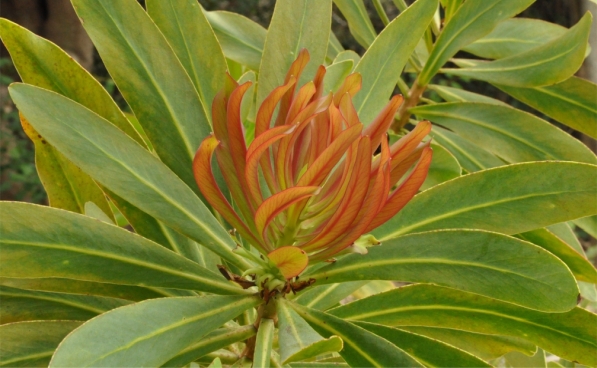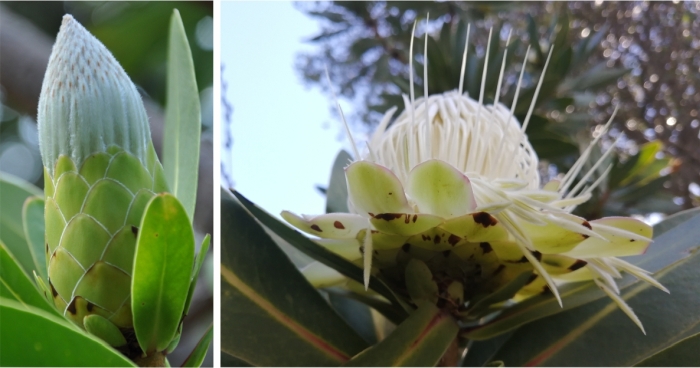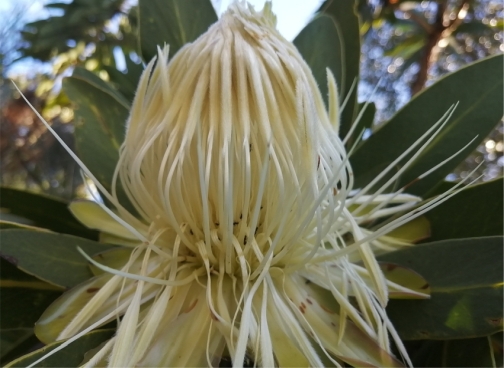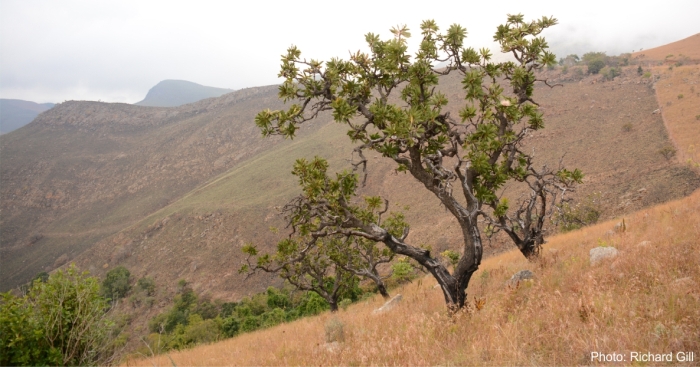Protea comptonii
Protea comptonii Beard
Family: Proteaceae
Common names: Barberton mountain sugarbush, Barberton sugarbush, Saddleback sugarbush, Compton’s protea (Eng.); barbertonse bergsuikerbos, barberton-suikerbos, compton-se-suikerbos (Afr.); sidlungu, sicalabane (SiSwati)
SA Tree No: 88
Introduction
A very impressive standing tree with a rounded, open crown, rich green leaves, and a water-lily-like inflorescence when fully in bloom, made up of white flowers.

Fig. 1. Protea comptonii inflorescence.
Description
Description
Protea comptonii is a medium-sized evergreen tree that grows to 4-8 m high. The tree has grey, corky, thick bark about 20 mm thick on the main stem, which reaches up to 450 mm in diameter. The branches are stout, 10-20 mm in diameter. The leaves are oblanceolate to elliptic, large, 120-250 mm long, 25-50 mm wide, dark green, hairless, thick, leathery, with a red margin. A large number of red new leaves appear at the beginning of the growing season.

Fig. 2. New leaves of Protea comptonii.
Protea comptonii produces stalkless, ovate inflorescences that are 80-120 mm in diameter. The involucral bracts are 15 mm long and 15-20 mm wide; the outer series is hairless and triangular, clearly visible before the bracts open. The inner series is approximately 50-60 mm long and 10-20 mm wide. When the involucral bracts open, they form a flattened saucer-like structure that holds the floral parts. Initially, the flowers are creamy white, but as the perianth fades, they develop a light pinkish blush.

Fig. 3. Involucral bracts of Protea comptonii when the inflorescence is closed (left) and open (right).
There are male and female elements present in the same flower; the male consists of stamens and anthers, and the female consists of stigma and pollen presenter. Styles are white, 65-80 mm long and curved inwards; pollen presenters are thread-like and knee-bent at the base. This species blooms from autumn (May), through winter to spring (September), but its peak occurs in early winter, between May and July, and the fruits are released in early summer, between October and November.

Fig. 4. A closer view of the inflorescence of Protea comptonii showing the flowers, stick-like stigma with the pollen presenter at the tip and the thread-like perianth with the anthers attached.
Conservation Status
Status
Protea comptonii is listed as Vulnerable (VU) on the Red List of South African Plants. The threats are mainly timber plantations, too frequent fire, alien invasive plants and browsing. The threats in Eswatini are mainly caused by too frequent fire, alien invasive plants and habitat loss due to mining. In the Barberton Mountains, about 26% of its habitat has been lost to timber plantations and this habitat is irreversibly modified. Overall, the population reduction in the past is 23-28%, over three generations (150-300 years). The remaining habitat is now protected in Songimvelo and Barberton Nature Reserves. These reserves have served to stop the continual loss of habitat to timber plantations on these Barberton mountains, where the remaining populations are.
In Songimvelo Nature Reserve, the grazing of livestock is aiding the spread of the alien invasive plants and causing degradation of the grasslands. However, the grazing of livestock seems unlikely to impact on P. comptonii directly, as they prefer the grass. The impact of browsing by antelope on P. comptonii is observed at Ithala Game Reserve, and too frequent fire (biennial burns) is another cause of the decline of this species.

Fig. 5. Protea comptonii in flower in habitat in recently burned grassland, near Barberton, Mpumalanga. Photo by Richard Gill.
Distribution and habitat
Distribution description
Protea comptonii is found in Eswatini and two South African Provinces, Mpumalanga and in the hills surrounding Vryheid in northern KwaZulu-Natal. The species has a small population of 3 150-6 300 plants with the largest subpopulation in the Barberton region and Songimvelo Nature Reserve near the border with Eswatini. This subpopulation is found growing on the grassland and between the plantations where several hundred mature individual plants still exist and the rest of subpopulations consists of fewer than 200 plants. The Eswatini subpopulation had three localities with approximately 200 plants of which two are close to the border. The subpopulation in Mpumalanga grows on the mountains, south of Barberton to north-western Eswatini. The Vryheid subpopulation is extinct and plants only remain in Ithala Game Reserve in eight small localities of less than 1 100 individual plants.
This species creates a protea woodland by its existence, in this subtropical region at 1 200-1 600 m altitude, growing on quartzite outcrops, on the steep, grassy, south-facing slopes in montane grassland and on mountains.

Fig. 6. Protea comptonii near Barberton, Mpumalanga. Photo by Richard Gill.
Derivation of name and historical aspects
History
The Proteaceae is a family of one magnificent flowering plant after another. It comprises of more than 1 700 species and 80 genera. Most of the about 800 species and 45 genera are native to Australia. Africa has about 400 species of which 352 species occur in South Africa, mainly in the winter-rainfall area of the Western Cape. Other species occur in Central and South America, islands east of New Guinea, New Caledonia, Madagascar, Southeast Asia, New Guinea and New Zealand.
The genus Protea was named by Carl Linnaeus, the father of taxonomy, after Proteus the mythological Greek god who could see into the future and always spoke the truth. However, to be able to extract a prophecy, one had to grasp him while he changed into numerous animate or inanimate forms.
Protea comptonii was discovered by Professor R.H. Compton in June 1947. He was the second Director of Kirstenbosch and the National Botanical Gardens of South Africa, from 1919 to 1953. He collected the species while traversing the mountain pass between the Havelock asbestos mine and Barberton on his first visit to Swaziland, now Eswatini. The species name comptonii thus honours him, Robert Harold Compton, 1886-1979. The species was first introduced into horticulture and shared with the public in 1960 by Mrs. E.R. Middelmann through her firm Honingklip Nursery.

Fig. 7. Protea comptonii in flower in Kirstenbosch NBG, July 2021.
Ecology
Ecology
Protea comptonii is pollinated by birds. When proteas finish flowering, they normally close the involucral bracts over the dead flowers to retain or store the seeds on the plant. However this is different on P.comptonii as the bracts remains open and allow the flowers, style and seeds to loosen and fall to the ground. The seeds are released (dehisce) in October but November is the best month for seed collection for abundance of release. The released seeds will then be available for wind dispersal and by the end of January all the seeds will be released and only the empty flowerheads remain. The ripening and release of seeds occurs during the six month period after the plants begin to flower.
Through its thick, protective bark, Protea comptonii is able to survive grassland fires and it has the ability to resprout from aerial stems. Older trees are gnarled and gaunt and live for approximately 50 to 100 years.

Fig. 8. Bark of Protea comptonii.
Uses
Use
In its natural habitat, Protea comptonii forms a beautiful protea woodland where it often grows with Protea roupelliae subspecies roupelliae, Protea caffra and Faurea speciosa. This is a tree that is best suited for subtropical climates, suitable for both small and huge gardens. However,, the tree also grows in Kirstenbosch National Botanical Garden, where it appears to have adapted well to the temperate, Mediterranean climate.

Fig. 9. Protea comptonii growing in Kirstenbosch NBG.
Growing Protea comptonii
Grow
Protea comptonii is a wonderful and adaptable species, once it is established it does not seem to need different water requirements. A tree at Kirstenbosch grows very well without water during the summer months, but receives abundant rainfall during the winter.
Protea comptonii is propagated by seed collected in early summer (October to December) and sown in the following spring (August to September). It is important to select fertile seeds, which are plump, whereas infertile seeds show no substance. The seeds are to be treated by dusting them with a systemic fungicide, to prevent rotting of the seeds. Sow the seeds in well-drained soil and cover the seed lightly with a thin layer of soil. Keep monitoring the soil moisture and allow the soil to dry out a little between watering.
The seed begins to germinate 21 days after sowing. However, if the seeds are sowed in autumn, they will take longer to germinate. The seedlings produce fleshy cotyledons, followed by true leaves and develop a lignotuber during the first few years. The seedlings grow extremely slowly, reaching a height of 10 cm after three years and having developed a number of branches within that time period. Pot up the seedlings at the cotyledon stage, or when the first true leaves appear; this reduces the plant stress and advances the survival rate. Plant the plants in the garden during the spring season and water them until the tree roots are established. The plants will begin to flower after about ten years when propagated by seed.
Propagation from cuttings has been unsuccessful because the leaves develop a fungal infection, turn black and drop.
References
- Gill, R. 2022. Observation of Protea comptonii, Ehlanzeni, Mpumalanga. iNaturalist. Online. https://www.inaturalist.org/observations/129411880.
- Gill, R. 2022. Observation of Protea comptonii, Ehlanzeni, Mpumalanga. iNaturalist. Online. https://www.inaturalist.org/observations/129411887.
- Protea Atlas Project. Meaning of Scientific Names. http://www.proteaatlas.org.za/meanings.htm. Accessed on 06 May. 2023.
- Rebelo, A.G. 2001. Proteas. A field guide to the proteas of southern Africa, edn 2. Fernwood Press, Vlaeberg, Cape Town.
- Rebelo, A.G., Mtshali, H. & von Staden, L. 2019. Protea comptonii Beard. National Assessment: Red List of South African Plants version 2020.1. Accessed on 2023/05/02.
- Rourke, J.P. 1980. The proteas of southern Africa. Purnell, Cape Town.
- Schmidt, E., Lötter, M. & McCleland, W. 2002. Trees and shrubs of Mpumalanga and Kruger National Park. Jacana, Johannesburg.
- Treetags. National Indigenous Trees. https://www.treetags.co.za/national-list-of-indigenous-trees/. Accessed on 06 May. 2023.
- Vogts, M. 1989. South Africa’s Proteaceae. Know them and grow them. Struik Publishers, Cape Town.
Credits
Mashudu Nndanduleni
Kirstenbosch National Botanical Garden
June 2023
Acknowledgements: the author thanks Richard Gill for pictures of Protea comptonii in habitat near Barberton in Mpumalanga, all other images taken at Kirstenbosch NBG.
Plant Attributes:
Plant Type: Tree
SA Distribution: KwaZulu-Natal, Mpumalanga
Soil type: Loam
Flowering season: Winter
PH: Neutral
Flower colour: White, Cream
Aspect: Full Sun
Gardening skill: Average
Special Features:
Horticultural zones









Rate this article
Article well written and informative
Rate this plant
Is this an interesting plant?
Login to add your Comment
Back to topNot registered yet? Click here to register.